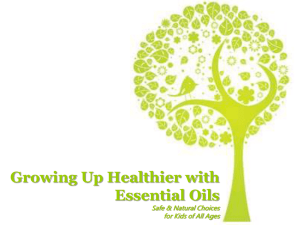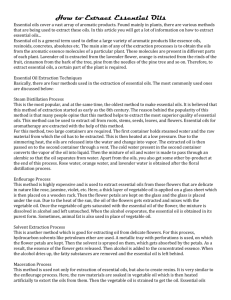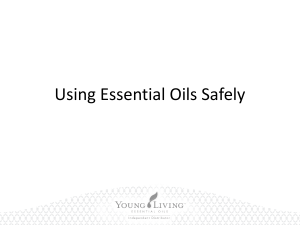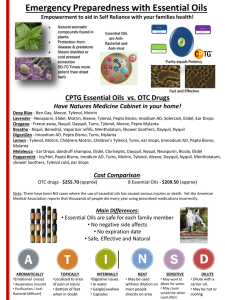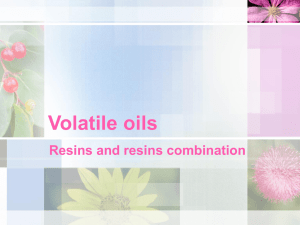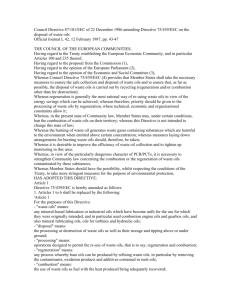Vegetable Oils
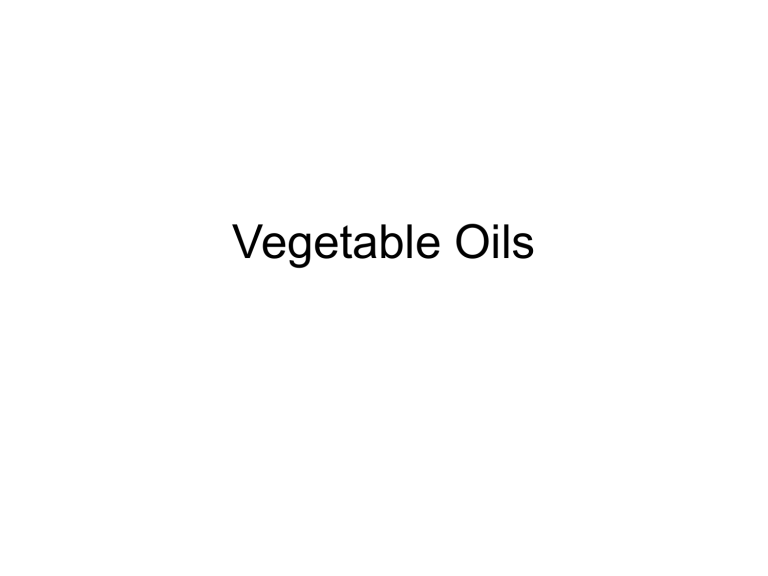
Vegetable Oils
Where is the oil located?
• Plants use stored oil as food for germinating embryo, caloric content is high so is efficient storage material. Double that of carbohydrates and proteins.
• Oil can be stored in endosperm (castor, coconut), cotyledons (peanut, soybean), scutellum (corn), fruit pulp (palms and olives).
• Seeds have organelles called as glyxosomes that convert fatty acids into carbohydrates during germination.
Oils
• Mainly hydrocarbons made up of
– Glycerol (backbone) with three fatty acids chemically bonded to it - triglycerides
Cholesterol
Unsaturation
• The number of double bonds determines the level of saturation.
• Vegetable oils are complex mixtures and saturation levels cannot be calculated directly very easily;
• % saturation is determined by Iodine method,
• Iodine breaks ='s and is incorporated. Amount of
Iodine left over is determined. Iodine values range from 7 to >200. 70 are called fats (solid at room temperature) and higher values correspond to more unsaturation.
Unsaturation and Iodine Value
• Drying - >150 thin film will dry into impervious coating
• Semidrying - 100-150
• Nondrying - 70-100
• Fats 70
http://discovermagazine.com/2001/mar/featchemistry/
Soap making
• Soap is salt of fatty acid
+3NaOH
3 RCOO-
Na+
+
Soap Making
• Water lye (Base)
• Add oil or fat
– Glycerol and fatty acids separate
– Fatty acids will react with base to form salt of fatty acid
– Head which is soluble in water
– Tail soluble in oil
Oil Paints and Varnishes
• Drying or semidrying oils (linseed & tung oil)
– oil paints are boiled with heavy metal containing compounds (Mg, Co, Pb) which help oils absorb oxygen and form a hard film;
– varnishes are produced by mixing boiled oils with resins or gums;
– enamels are varnishes + pigments;
– paints do not contain gums or resins
• Latex paints - alkyd resins which are manufactured from fatty acids cleaved from vegetable oils, water soluble
Linoleum and Jojoba
• Made up of Oils + gums + synthetic resins + pigments;
– oils are "blown" which thickens them and makes them soluble in petroleum oils (resins)
– linoleum is not used much in U.S. anymore.
• Jojoba - oils is esters rather than triglycerides, originally thought to be good substitute for sperm oil but is not because of high temperature breakdown; however is useful in medicine and cosmetics.
Extraction
• Grinding with stones
- cold pressing – high quality
• Steam driven stone press
– hot pressing
• Screw press - continuous feed
• Solvent extraction - follows screw press, hexane
Refining
• Removal of free fatty acids
• Degumming - removes mucilaginous material
• Bleaching - removal of pigments
• Deodorized - steam heating
• Winterize - prevents clouding by chilling oil and filtering out particles.
• Hydrogenation - yields vegetable lards, margarine and cheese substitutes
Drying Oils
High in double bonds in FA
• Linseed oil Linum usitatissimum , seeds, waterrepellent glaze
– mostly non-edible oils
• due to unpleasant flavor
• Cyanogenic glycosidesand
• rapid rancidity due to lots of double bonds.
– also source of flax
• Tung oil Aleurites (Euphorbiaceae), seeds, poisonous (not edible), used in paints, waterproof coverings and caulking. Once grown in U.S. but most now comes from China.
Semi-drying Oil
Few double bonds in FA
•
Safflower oil Carthamus tinctorius , thistles, oil is from seeds, used in cooking oils, salad dressings, margarine, high I value so low in calories but oxidizes readily
– Produces dye
•
Soybean oil
–
Glycine max already covered, stores well, used in salad and cooking oils and artificial "fluffy" products.
•
Sunflower oil Helianthus annuus - native North American plant but development of large-headed cultivars is largely credited to Russians; used as salad and cooking oil; paints, varnishes and resins; added to diesel fuel.
Considered equal to olive oil, used for production of margarines.
•
Corn oil
–
Zea mays salad dressing and margarines, stable but smokes at high temp.
•
Sesame oil Sesamum indicum , from Ethiopia, highly resistant to oxidation due an antioxidant compound called sesamolin, most is consumed and produced in Africa,
Middle East, India and China
• Cottonseed oil – Gossypium barbedensis byproduct of cotton fiber production, must remove gossypol (toxic to most animals except cows); Wesson oil, hydrogenation --->
Crisco
• Rapeseed oil Brassica napus , edible oil but possibly toxic, most useful as machine oil as an lubricant
Non-drying Oil
• Peanut oil Arachis hypogaea, premium cooking oil
• Olive oil Olea europea , obtained from fruit pulp,
– Gentle pressing of the olive – virgin oil
– Further pressing – first, second grade oils
– Has monounsaturated fat – good for health.
• Castor oil - R icinus communis
– Laxative – ricinoleic acid
– poison - ricine (alkaloid) and ricin (highly toxic protein); used in soaps, paints, lubricants
Vegetable Fat
• Oil palms Elaeis guinensis, distinct oils are obtained from fruit pulp and seeds
– kept separate due to differences in chemical composition; used in soap, candles, margarine and shortenings
– U.S. diets are avoiding fats and palm oils are taboo.
• Coconut oil Cocos nucifera , cosmetics and nondairy
"dairy" products
– At 20 o C becomes semisolid; at 15 o C becomes brittle
– Has free fatty acid – caprylic acid - smell
• Shea butter: Butyrospermum parkit
– 50% saturated fat
Oil or Fat
Butterfat
Canola oil
Coconut oil
Corn oil
Grape seed oil
Lard
Olive oil
Safflower oil*
Soybean oil
Sunflower oil*
Relative effect of fats on Total Cholesterol
Myristic acid
C14:0
0
0
2
0
11
0
18
0
0
0
Palmitic acid
C16:0
11
8
26
13
27
4
9
7
11
7
Linoleic acid
C18:2
58
73
10
10
2
22
2
78
54
68
Alpha
Linolenic
Acid
C18:3
1
0
0
1
1
10
0
0
7
1
* Not high-oleic
Dietary
Cholesterol
273
0
0
0
0
77
0
0
0
0
Delta TC
Change in cholesterol level
1788
-514
1674
-870
-1196
630
88.6
-1310
-908
-1142
Wax
• Long chain alcohol and long chain fatty acid
• Jojoba wax: Simmondsia chinensis
– Seeds contain liquid wax
– Similar to sperm whale oil

